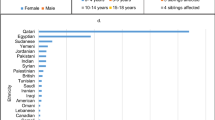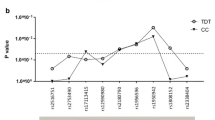Abstract
The primary cause of neurological syndromes with antibodies against glutamic acid decarboxylase 65 (GAD65-Ab) is unknown, but genetic predisposition may exist as it is suggested by the co-occurrence in patients and their relatives of other organ-specific autoimmune diseases, notably type 1 diabetes mellitus (T1DM), and by the reports of a few familial cases. We analyzed the human leukocyte antigen (HLA) in 32 unrelated patients and compared them to an ethnically matched sample of 137 healthy controls. Four-digit resolution HLA alleles were imputed from available Genome Wide Association data, and full HLA next-generation sequencing-based typing was also performed. HLA DQA1*05:01–DQB1*02:01–DRB1*03:01 was the most frequent class II haplotype in patients (13/32, 41%). DQB1*02:01 was the only allele found to be significantly more common in patients than in controls (20/137, 15%, corrected p = 0.03, OR 3.96, 95% CI [1.54–10.09]). There was also a trend towards more frequent DQA1*05:01 among patients compared to controls (22/137, 16%; corrected p = 0.05, OR 3.54, 95% CI [1.40–8.91]) and towards a protective effect of DQB1*03:01 (2/32, 6% in patients vs. 42/137, 31% in control group; corrected p = 0.05, OR 0.15, 95% CI [0.02–0.65]). There was no significant demographic or clinical difference between DQ2 and non-DQ2 carriers (p > 0.05). Taken together, these findings suggest a primary DQ effect on GAD65-Ab neurological diseases, partially shared with other systemic organ-specific autoimmune diseases such as T1DM. However, it is likely that other non-HLA loci are involved in the genetic predisposition of GAD65-Ab neurological syndromes.
Similar content being viewed by others
References
Saiz A, Blanco Y, Sabater L et al (2008) Spectrum of neurological syndromes associated with glutamic acid decarboxylase antibodies: diagnostic clues for this association. Brain 131:2553–2563. https://doi.org/10.1093/brain/awn183
Honnorat J, Saiz A, Giometto B et al (2001) Cerebellar ataxia with anti-glutamic acid decarboxylase antibodies: study of 14 patients. Arch Neurol 58:225–230. https://doi.org/10.1001/archneur.58.2.225
García García ME, Castrillo SM, Morales IG et al (2013) Acute amnesia and seizures in a young female. Epileptic Disord 15:455–460. https://doi.org/10.1684/epd.2013.0607
Dalmau J, Tüzün E, Wu H et al (2007) Paraneoplastic anti-N-methyl-d-aspartate receptor encephalitis associated with ovarian teratoma. Ann Neurol 61:25–36. https://doi.org/10.1002/ana.21050
Armangue T, Spatola M, Vlagea A et al (2018) Frequency, symptoms, risk factors, and outcomes of autoimmune encephalitis after herpes simplex encephalitis: a prospective observational study and retrospective analysis. Lancet Neurol 17:760–772. https://doi.org/10.1016/S1474-4422(18)30244-8
Gresa-Arribas N, Ariño H, Martínez-Hernández E et al (2015) Antibodies to inhibitory synaptic proteins in neurological syndromes associated with glutamic acid decarboxylase autoimmunity. PLoS ONE 10:e0121364. https://doi.org/10.1371/journal.pone.0121364
Burns TM, Jones HR, Phillips LH et al (2003) Clinically disparate stiff-person syndrome with GAD65 autoantibody in a father and daughter. Neurology 61:1291–1293. https://doi.org/10.1212/01.wnl.0000092016.98256.21
Xiao Z, Shan J, Huang X et al (2015) Familial case reports of stiff-person syndrome. Clin Neurophysiol 126:2408–2409. https://doi.org/10.1016/j.clinph.2015.03.010
Kuchling J, Shababi-Klein J, Nümann A et al (2014) GAD antibody-associated late-onset cerebellar ataxia in two female siblings. Case Rep Neurol 6:264–270. https://doi.org/10.1159/000369784
Belbezier A, Joubert B, Montero-Martin G et al (2018) Multiplex family with GAD65-Abs neurologic syndromes. Neurol Neuroimmunol Neuroinflamm 5:e416. https://doi.org/10.1212/NXI.0000000000000416
Pugliese A, Solimena M, Awdeh ZL et al (1993) Association of HLA-DQB1*0201 with stiff-man syndrome. J Clin Endocrinol Metab 77:1550–1553. https://doi.org/10.1210/jcem.77.6.8263140
Dalakas MC, Fujii M, Li M, McElroy B (2000) The clinical spectrum of anti-GAD antibody-positive patients with stiff-person syndrome. Neurology 55:1531–1535. https://doi.org/10.1212/wnl.55.10.1531
Costa M, Saiz A, Casamitjana R et al (2002) T-cell reactivity to glutamic acid decarboxylase in stiff-man syndrome and cerebellar ataxia associated with polyendocrine autoimmunity. Clin Exp Immunol 129:471–478. https://doi.org/10.1046/j.1365-2249.2002.01931.x
Klein J, Sato A (2000) The HLA system. N Engl J Med 343:702–709. https://doi.org/10.1056/NEJM200009073431006
Hollenbach JA, Oksenberg JR (2015) The immunogenetics of multiple sclerosis: a comprehensive review. J Autoimmun 64:13–25. https://doi.org/10.1016/j.jaut.2015.06.010
Mignot E, Lin X, Arrigoni J et al (1994) DQB1*0602 and DQA1*0102 (DQ1) are better markers than DR2 for narcolepsy in Caucasian and black Americans. Sleep 17:S60–67. https://doi.org/10.1093/sleep/17.suppl_8.s60
Kim T-J, Lee S-T, Moon J et al (2017) Anti-LGI1 encephalitis is associated with unique HLA subtypes: HLA subtypes in anti-LGI1 encephalitis. Ann Neurol 81:183–192. https://doi.org/10.1002/ana.24860
van Sonderen A, Roelen DL, Stoop JA et al (2017) Anti-LGI1 encephalitis is strongly associated with HLA-DR7 and HLA-DRB4: anti-LGI1 encephalitis. Ann Neurol 81:193–198. https://doi.org/10.1002/ana.24858
Gaig C, Graus F, Compta Y et al (2017) Clinical manifestations of the anti-IgLON5 disease. Neurology 88:1736–1743. https://doi.org/10.1212/WNL.0000000000003887
Zheng X, Shen J, Cox C et al (2014) HIBAG—HLA genotype imputation with attribute bagging. Pharmacogenom J 14:192–200. https://doi.org/10.1038/tpj.2013.18
Han F, Faraco J, Dong XS et al (2013) Genome wide analysis of narcolepsy in china implicates novel immune loci and reveals changes in association prior to versus after the 2009 H1N1 influenza pandemic. PLoS Genet 9:e1003880. https://doi.org/10.1371/journal.pgen.1003880
Wang C, Krishnakumar S, Wilhelmy J et al (2012) High-throughput, high-fidelity HLA genotyping with deep sequencing. Proc Natl Acad Sci USA 109:8676–8681. https://doi.org/10.1073/pnas.1206614109
Erlich H, Valdes AM, Noble J et al (2008) HLA DR-DQ haplotypes and genotypes and type 1 diabetes risk: analysis of the type 1 diabetes genetics consortium families. Diabetes 57:1084–1092. https://doi.org/10.2337/db07-1331
Kulmala P, Savola K, Reijonen H et al (2000) Genetic markers, humoral autoimmunity, and prediction of type 1 diabetes in siblings of affected children. Childhood Diabetes in Finland Study Group. Diabetes 49:48–58. https://doi.org/10.2337/diabetes.49.1.48
The TEDDY Study Group, Krischer JP, Lynch KF et al (2015) The 6 year incidence of diabetes-associated autoantibodies in genetically at-risk children: The TEDDY Study. Diabetologia 58:980–987. https://doi.org/10.1007/s00125-015-3514-y
De Block CEM, De Leeuw IH, Rooman RPA et al (2000) Gastric parietal cell antibodies are associated with glutamic acid decarboxylase-65 antibodies and the HLA DQA1*0501–DQB1*0301 haplotype in Type 1 diabetes mellitus. Diabet Med 17:618–622. https://doi.org/10.1046/j.1464-5491.2000.00354.x
Howson JMM, Stevens H, Smyth DJ et al (2011) Evidence that HLA Class I and II associations with type 1 diabetes, autoantibodies to GAD and autoantibodies to IA-2, are distinct. Diabetes 60:2635–2644. https://doi.org/10.2337/db11-0131
Sørgjerd EP, Thorsby PM, Torjesen PA et al (2015) Presence of anti-GAD in a non-diabetic population of adults; time dynamics and clinical influence: results from the HUNT study. BMJ Open Diabetes Res Care 3:e000076. https://doi.org/10.1136/bmjdrc-2014-000076
Bender C, Schlosser M, Christen U et al (2014) GAD autoantibody affinity in schoolchildren from the general population. Diabetologia 57:1911–1918. https://doi.org/10.1007/s00125-014-3294-9
Kozhakhmetova A, Wyatt RC, Caygill C et al (2018) A quarter of patients with type 1 diabetes have co-existing non-islet autoimmunity: the findings of a UK population-based family study: multiple autoimmunity in type 1 diabetes. Clin Exp Immunol 192:251–258. https://doi.org/10.1111/cei.13115
Boehm BO, Kühnl P, Löliger C et al (1993) HLA-DR3 and HLA-DR5 confer risk for autoantibody positivity against the thyroperoxidase (mic-TPO) antigen in healthy blood donors. Clin Investig 71:221–225
Kawasaki E, Takino H, Yano M et al (1994) Autoantibodies to glutamic acid decarboxylase in patients with IDDM and autoimmune thyroid disease. Diabetes 43:80–86. https://doi.org/10.2337/diab.43.1.80
Rharbaoui F, Mayer A, Granier C et al (1999) T cell response pattern to glutamic acid decarboxylase 65 (GAD65) peptides of newly diagnosed type 1 diabetic patients sharing susceptible HLA haplotypes. Clin Exp Immunol 117:30–37. https://doi.org/10.1046/j.1365-2249.1999.00945.x
Herman AE, Tisch RM, Patel SD et al (1999) Determination of glutamic acid decarboxylase 65 peptides presented by the type I diabetes-associated HLA-DQ8 class II molecule identifies an immunogenic peptide motif. J Immunol 163:6275–6282
Yang J, James EA, Sanda S et al (2013) CD4+ T cells recognize diverse epitopes within GAD65: implications for repertoire development and diabetes monitoring. Immunology 138:269–279. https://doi.org/10.1111/imm.12034
Li CW, Osman R, Menconi F et al (2017) Flexible peptide recognition by HLA-DR triggers specific autoimmune T-cell responses in autoimmune thyroiditis and diabetes. J Autoimmun 76:1–9. https://doi.org/10.1016/j.jaut.2016.09.007
Pociot F, Akolkar B, Concannon P et al (2010) Genetics of type 1 diabetes: what’s next? Diabetes 59:1561–1571. https://doi.org/10.2337/db10-0076
Shen C, Gao J, Sheng Y et al (2016) Genetic susceptibility to vitiligo: GWAS approaches for identifying vitiligo susceptibility genes and loci. Front Genet 7:3. https://doi.org/10.3389/fgene.2016.00003
Simmonds MJ (2013) GWAS in autoimmune thyroid disease: redefining our understanding of pathogenesis. Nat Rev Endocrinol 9:277–287. https://doi.org/10.1038/nrendo.2013.56
Acknowledgements
We thank NeuroBioTec Hospices Civils de Lyon BRC (AC-2013-1867, NFS96-900) for banking DNA samples. This study is supported by research Grants from ANR (ANR-14-CE15-0001-MECANO) and FRM (Fondation pour la recherche médicale) DQ20170336751. This work has been developed within the BETPSY project, which is supported by a public Grant overseen by the French National Research Agency (ANR), as part of the second “Investissements d´Avenir” program (reference ANR-18-RHUS-0012). SM-C is supported by a research grant from Fundación Alfonso Martín Escudero (Spain). We thank Philip Robinson for help in manuscript preparation (Direction de la Recherche Clinique, Hospices Civils de Lyon).
Author information
Authors and Affiliations
Corresponding author
Ethics declarations
Conflicts of interest
The authors declare that they have no conflicts of interest.
Ethical standards
All procedures were performed in accordance with the institutional ethics committee and the Declaration of Helsinki.
Electronic supplementary material
Below is the link to the electronic supplementary material.
Supplementary Fig.
The first two (C1 and C2) genetic principal components (PC) scatter plot. PC analysis is a statistical tool that reduces data dimension, describing a large amount of data as new, un-correlated variables, labeled PC. Genotypes of patients (GAD) and controls were converted in 9 PC based on single nucleotide polymorphisms. Comparing PC by scatter plot enabled to guide case–control ethnical matching. (TIFF 11720 kb)
Rights and permissions
About this article
Cite this article
Muñiz-Castrillo, S., Ambati, A., Dubois, V. et al. Primary DQ effect in the association between HLA and neurological syndromes with anti-GAD65 antibodies. J Neurol 267, 1906–1911 (2020). https://doi.org/10.1007/s00415-020-09782-8
Received:
Revised:
Accepted:
Published:
Issue Date:
DOI: https://doi.org/10.1007/s00415-020-09782-8




